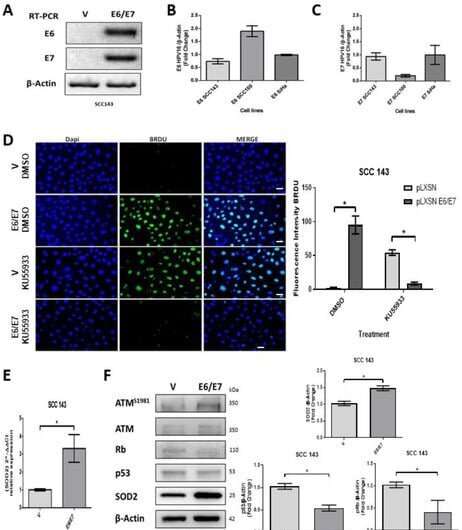This article has been reviewed according to Science X's editorial process and policies. Editors have highlighted the following attributes while ensuring the content's credibility:
fact-checked
trusted source
proofread
Cigarette smoke and HPV have synergistic effects on cells, heightening the risk of head and neck cancer

Tobacco smoking and human papillomavirus (HPV) are both well-known risk factors for head and neck cancer, but there is ample evidence to show they can interact to further increase the risk of contracting the disease, according to a study by scientists at the University of São Paulo (USP) in Brazil and the University of Chile. An article on the study is published in the International Journal of Molecular Sciences.
The results of the study clarify aspects of the molecular mechanisms involved in head and neck cancer, paving the way for novel strategies of prevention and treatment, or other interventions that could benefit patients.
Head and neck cancer is a group of cancers of the mouth, nose, sinuses, tonsils, throat and thyroid. It affected some 830,000 people worldwide in 2020, causing the death of more than 50%. In Brazil it caused almost 21,000 deaths in 2019, according to the most recent data from the National Cancer Institute (INCA). Historically speaking, its main causes have been alcohol, tobacco and poor oral hygiene, but in recent decades HPV has become a significant risk factor, especially for younger people and relatively well-off patients. Head and neck cancer is now one of the fastest-rising types of cancer associated with HPV in the world.
"Instead of continuing to analyze smoking and HPV as oncogenic factors separately, we set out to focus on their possible interaction," said Enrique Boccardo, penultimate author of the article and a professor in the Department of Microbiology at the University of São Paulo's Biomedical Sciences Institute (ICB-USP) in Brazil.
"Both smoking and HPV are associated with heightened oxidative stress and DNA damage, which are factors in cancer, and according to previous research, can regulate superoxide dismutase 2 [SOD2], a putative biomarker of oral cancer malignancy and other diseases associated with HPV."
The researchers first conducted in vitro experiments to analyze oral cells that expressed the oncoproteins HPV16 E6 and E7 [showing infection by HPV] and were exposed to cigarette smoke condensate. Levels of SOD2 and DNA damage were found to increase significantly compared with controls, pointing to harmful interaction between HPV and cigarette smoke.
The control cells expressed less SOD2 than the cells that expressed E6 and E7 or the cells exposed to cigarette smoke, while the cells that expressed the oncoproteins and were exposed to cigarette smoke expressed more SOD2 than either, indicating interaction between the presence of HPV genes and cigarette smoke.
The second stage of the project involved an analysis of genomic data from 613 samples in The Cancer Genome Atlas (TCGA), a public repository containing the genetic mutations responsible for cancer (derived from genome sequencing and bioinformatics). The researchers focused on the analysis of SOD2 transcriptions to confirm the findings.
Starting point
"Although in vitro studies take place in an artificial environment, they're a starting point for an understanding of what happens in more complex models and could enable us in future to intervene objectively with some benefit," Boccardo said. "For example, HPV vaccination is currently available only from the SUS [Sistema Único de Saúde, Brazil's national health service] for children aged 9-14 because studies have evidenced its efficacy against genital pathologies, but I believe it should be possible to consider extending the age group in order to prevent diseases in other anatomical regions."
This study in particular, he added, translates the results obtained in the laboratory to clinical analysis by surmounting the "Achilles heel" of basic research, which is the difficulty of access to human samples, thanks to technological advances leading to the creation of databases for human samples like the one used in the study. These databases include RNA and protein expression analysis, as well as containing data collected over long periods.
"The next step would be to increase the complexity of the model utilized, analyzing the functional question in the context of normal expression of viral proteins, where the HPV promoter does in fact regulate E6 and E7 expression," Boccardo said. "We mustn't forget, for example, that events such as inflammatory processes can't be seen in vitro but are known to play a very important role in disease outcomes."
More information: Diego Carrillo-Beltrán et al, Interaction between Cigarette Smoke and Human Papillomavirus 16 E6/E7 Oncoproteins to Induce SOD2 Expression and DNA Damage in Head and Neck Cancer, International Journal of Molecular Sciences (2023). DOI: 10.3390/ijms24086907


















